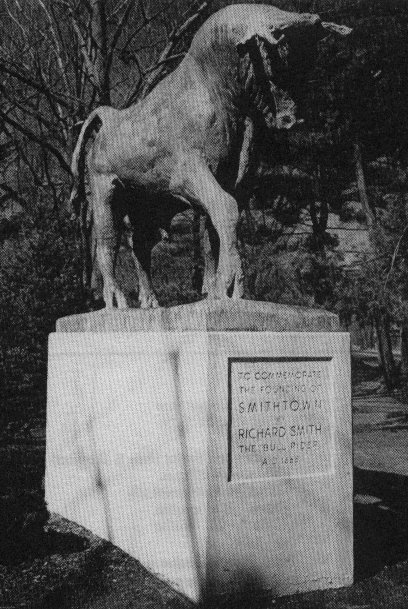 |
|
|
| Home Return to Long Island Genealogy |
Email |
| Home Return to Long Island Genealogy |
Email |
 |
|
|
One of the most
controversial figures in Long Island history is Richard (Bull) Smith (Smythe),
the founder of Smithtown. The owner of lands of vast extent, he was often
engaged in boundary disputes. His contest with the town of Huntington over
the boundary between it and his own lands was long and bitter, the courts
finally deciding in his favor. His wealth permitted him to buy land freely and he soon had assembled a
princely domain. He became one of the great men of Colonial Long Island.
Smith was buried near his home at Nissequogue.
The often repeated
story about Smith, and one which apparently lacks historical foundation,
recounts how he made an agreement with the Indians that he could have all
of the land which he could encircle in one day riding on the back of a
bull. From daylight to dusk he rode, so the legend goes, defining
a huge domain. This story, whether true or not, left its mark upon the
neighborhood; "Bread and Cheese Hollow" was so named, it is said, because
Mr. Smith tarried there on the momentous ride for his noon-day meal.
The bronze statue of
a bull, which was erected on a prominent corner of the village of Smithtown
to commemorate Smith's
reputed exploit, has met with considerable
disapproval throughout the years on the part of aesthetic- minded citizens.
The principal part of Smithtown originally was owned by Lion Gardiner who
received it from Grand Sachem Wyandanch in return for a noble service performed
by the Englishman. Gardiner procured the ransom of the chief's lovely daughter,
Heather Flower, who had been captured on her wedding night by a raiding
band of Narragansett Indians and carried off captive to Connecticut.
In a deed dated
July 14, 1659, and witnessed by Richard Smith, Wyandanch in the last year
of his life transferred the
Smithtown lands to Gardiner, his friend
and benefactor. This deed is in the possession of the Long Island Historical
Society in Brooklyn. Before his death in 1663, Gardiner in turn transferred
his entire rights to this land to Smith who later obtained a patent on
March 3, 1665, from Governor Nicoll of New York.
The first deed
of land from the Indians is dated 1650. Smith was a shrewd businessman
and had his deeds recorded with the local authorities on March 2, 1666,
and at the same time with the Secretary of State. In subsequent litigation
over the boundaries between Smithtown and Huntington, Smith's claims were
sustained in the courts.